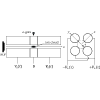Table-top ion-trap experiment on the stability of intense short bunches in linear hadron accelerators
IF 16.4
1区 化学
Q1 CHEMISTRY, MULTIDISCIPLINARY
引用次数: 0
Abstract
The novel experimental system “S-POD” (Simulator of Particle Orbit Dynamics) is employed to explore the stability of short hadron bunches in high-intensity linacs. In a previous study with the S-POD [M. Goto et al., ], a static potential was used to focus the bunch in the longitudinal direction. We here make a step forward to include the possibility of pure synchrotron resonance, introducing periodic modulation to the longitudinal potential well. The modulation period was taken a half of the transverse alternating-gradient focusing period, which reflects the most typical lattice condition of a drift-tube linac. Detailed stability maps are constructed to reveal dangerous parameter regions where serious beam loss may occur due to resonance. We reconfirm the existence of various betatron and synchrobetatron resonance stop bands whose widths and locations change in tune space depending on the bunch intensity. It turns out that the periodicity of the longitudinal focusing potential brings about no pronounced effect on the resonance feature; the result is very similar to what we obtained in the previous study with a static longitudinal potential. As long as the lattice periodicity mentioned above is maintained, no serious noncoupling synchrotron resonance appears even with a high synchrotron phase advance above 90° per unit alternating-gradient cell. Severe envelope instability may, however, be excited in the longitudinal direction if the axial focusing force includes error components that affect the original lattice periodicity. The experimental observations can be explained with the free from the concept of incoherent tune spread. Published by the American Physical Society 2024

关于直线强子加速器中强短束稳定性的台式离子阱实验
新型实验系统 "S-POD"(粒子轨道动力学模拟器)被用来探索短强子束在高强度直列加速器中的稳定性。在之前利用 S-POD 进行的研究中[后藤等人,],使用静态势能将束流聚焦在纵向方向上。我们在这里向前迈出了一步,将纯同步加速器共振的可能性纳入其中,在纵向势阱中引入了周期性调制。调制周期为横向交变梯度聚焦周期的一半,这反映了漂移管直列加速器最典型的晶格条件。我们绘制了详细的稳定性图,以揭示由于共振可能导致严重束流损失的危险参数区域。我们再次证实了各种贝塔特伦和同步贝塔特伦共振停止带的存在,其宽度和位置在调谐空间中的变化取决于束强度。事实证明,纵向聚焦势的周期性对共振特征没有明显的影响;这一结果与我们在之前的静态纵向势研究中得到的结果非常相似。只要保持上述晶格周期性,即使每单位交变梯度单元的同步辐射相位进角超过 90°,也不会出现严重的非耦合同步辐射共振。但是,如果轴向聚焦力包含影响原始晶格周期性的误差分量,则可能会在纵向激发严重的包络不稳定性。实验观察结果可以用非相干调幅概念来解释。 美国物理学会出版 2024
本文章由计算机程序翻译,如有差异,请以英文原文为准。
求助全文
约1分钟内获得全文
求助全文
来源期刊

Accounts of Chemical Research
化学-化学综合
CiteScore
31.40
自引率
1.10%
发文量
312
审稿时长
2 months
期刊介绍:
Accounts of Chemical Research presents short, concise and critical articles offering easy-to-read overviews of basic research and applications in all areas of chemistry and biochemistry. These short reviews focus on research from the author’s own laboratory and are designed to teach the reader about a research project. In addition, Accounts of Chemical Research publishes commentaries that give an informed opinion on a current research problem. Special Issues online are devoted to a single topic of unusual activity and significance.
Accounts of Chemical Research replaces the traditional article abstract with an article "Conspectus." These entries synopsize the research affording the reader a closer look at the content and significance of an article. Through this provision of a more detailed description of the article contents, the Conspectus enhances the article's discoverability by search engines and the exposure for the research.
 求助内容:
求助内容: 应助结果提醒方式:
应助结果提醒方式:


